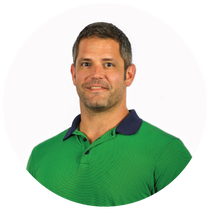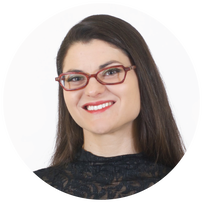|
Jaime Granchelli is a doctor of physical therapy here at Staszak Physical Therapy & Wellness Center. She is committed to helping patients thrive, regardless of their condition, in order to help them become and stay as active as possible.
Prior to studying physical therapy, Jaime practiced as a nutritionist, competed as an athlete, and spent over 10 years as a coach in several sports including tennis, skiing, swimming, CrossFit, olympic lifting, and track. She integrates her history of athletics and specialization of manual therapy into her hands-on diagnosing and treatment approach. She is currently working on her strength and conditioning certification as well as women’s health specializations. Jaime was born in upstate New York and moved to Texas where for her undergraduate studies. She ended up in St. Augustine, Florida for her doctorate program and since then has been all around the United States as a traveling physical therapist - including Eugene, Oregon where she fell in love with the Pacific Northwest. After saying "so long" to the whirlwind of traveling physical therapy (or at least taking a pause) in late fall of 2020, Jaime happily settled back here in Eugene with her fiancé Nick and their two fur babies; Ringo and Titus. Hiking, camping, fly fishing, exploring new places, making new friends, and visiting with family and friends are just a few things that bring joy and balance to their lives.
0 Comments
Nicole is an Oregon native, and she grew up in Springfield. Nicole is currently going to Oregon State University studying kinesiology with dreams of getting into a nursing program after finishing her degree.
In her spare time, Nicole enjoys going on road trips, exploring new waterfalls or hiking trails, and spending time with her family and cats. Nicole's favorite way to unwind and relax is being able to get over to the coast and have some ocean therapy; or being able to spend time with her family.  Samantha graduated from the University of Oregon in 2015 with a bachelors degree in Human Physiology. A few years later, she decided to attend Lane Community College for their massage therapy program, and completed it in 2019. Her style incorporates Swedish techniques with deep tissue, myofascial release, and trigger point holding. Samantha's approach to massage is primarily focused on pain reduction and injury recovery, as well as relieving tension from compensation patterns that have formed in clients’ bodies. Outside of work, Samantha enjoys playing soccer (both indoor and outdoor), going on hikes, taking vacations to tropical locations, and practicing yoga. by Bronwyn Gill, NTP
Hands down, one of the most important tools in a healthy kitchen is quality cookware. It’s a purchase that you’ll hopefully make once in a lifetime, yet we often go for what’s cheap and easy. Spoiler alert — nothing cheap or easy will ever benefit your pocketbook or health. Im going to cover the two types of cookware you’ll want to avoid, and which options are going to be the best long term investment for your kitchen and your body. The most popular, yet arguably the most toxic option people purchase is non-stick cookware with a plastic coating like Teflon. When Teflon is manufactured, a man-made chemical called Perfluorooctanoic acid (PFOA), also known as C8, is used in the process. PFOA is the most persistent synthetic chemical known to man and is found in the blood of nearly every person tested 1. Toxicologist Tim Kropp, Ph.D., a senior scientist with the Environmental Working Group, finds the situation alarming. He exclaims, “[PFOA] doesn't break down -- ever…It would take your body two decades to get rid of 95% of it, assuming you are not exposed to anymore. But you are.” Further, PFOA has been linked to birth defects, increased cancer rates, and changes to lipid levels, the immune system, and liver. It is likely a human carcinogen and it is highly persistent in the environment 2. The second cookware option you’ll want to avoid is aluminum. While aluminum is the most abundant metal in the earth's crust and occurs naturally in soil, water, and air, its use is also widespread among many consumer products. You can find aluminum used and distributed in cookware, antacids, astringents, buffered aspirin, food additives, antiperspirants, and cosmetics. Specifically, aluminum cookware has been shown to leach a significant amount of aluminum into food during cooking, which could pose a toxicity threat. In humans, high levels of aluminum in the body have been shown to cause brain and bone disease, while studies in animals have shown that the nervous system is a sensitive target of aluminum toxicity 3. The EWG has placed aluminum on their “watch list” due to its extensive use and the uncertainty surrounding this metal and its long term, cumulative health effects 4. For these reasons, avoiding aluminum exposure in your cookware is generally a good idea. Now that we’ve covered the two types of cookware to completely avoid, let’s move onto the two types of cookware you want to have in your kitchen. Oh, and if you’re wondering how to cook your morning omelet without major sticking…we’ll cover that too. Your first option is going to be stainless steel. Stainless steel is easy to maintain, heats up quickly and evenly, can be put in the oven, and will last a lifetime. If the financial commitment of a new stainless steel set is too steep, simply start by purchasing the pieces you use the most and build your perfectly curated collection overtime. The most common complaint with stainless steel cookware is the fact that foods stick. This could happen if you don’t have the proper technique! To ensure a perfect non-stick surface be sure to heat the pan first, add your healthy fat or oil, and then the food. With some practice, it’ll become quite easy, promise! The second option is cast iron. The first known use of cast iron cookware was during the Han Dynasty in China, around 220 A.D. Casting techniques became widespread in Europe by the 16th century, and since then, this versatile equipment has been a staple in households all over the world 5. Cast iron is non-stick, easy to clean, very inexpensive, basically indestructible, will last a lifetime, and is visually appealing. Well maintained cast iron can be passed down for generations making this not only healthy for you but a better way to create a healthy legacy in your family! Cast iron does require maintenance and care through proper “seasoning” to keep them rust-free and non-stick, but this process is quick and easy. Be sure to follow the manufacturer's guidance on how to do this! There we have it — the two pieces of cookware to avoid and the two to go out and purchase today! Happy cooking. 1. DeNoon, Daniel J. “Is Teflon Chemical Toxic? EPA Seeks Answers.” WebMD, WebMD, 13 Jan. 2005, www.webmd.com/cancer/news/20050113/is- teflon-chemical-toxic-epa-seeks-answers#1. 2. Ewg. “New Study and New Dangers of the Old Toxic Teflon Chemical.” EWG, www.ewg.org/enviroblog/2009/…/new-study-and-new-dangers-old- toxic-teflon-chemical. 3. “Toxic Substances Portal - Aluminum.” Centers for Disease Control and Prevention, Centers for Disease Control and Prevention, 21 Jan. 2015, www.atsdr.cdc.gov/phs/phs.asp?id=1076&tid=34. 4. “Food Additive ‘Watch List.’” EWG, www.ewg.org/research/ewg-s-dirty- dozen-guide-food-additives/food-additive-watch-list. 5. Bomberger, Sabrina. “The History and Resurgence of Cast Iron Cookware.” WebstaurantStore, WebstaurantStore, 6 July 2016, www.webstaurantstore.com/…/…/history-and-resurgence-of-cast- iron-cookware.html.  Farrah holds a B.S. in Human Physiology from the University of Oregon and graduated from East West College of Healing Arts in 2008. She received training in Swedish and Deep Tissue massage, as well as Myofascial Release, and Trigger Point therapy. Since graduating, she has practiced in spas, clinics and private practice where each session is customized to fit the client’s individual needs. As a massage therapist, Farrah practices therapeutic bodywork with intention and care. If you seek relief from pain or stress, desire to feel better in your body, need help working through an injury, or overcoming a long-term structural issue, she is here to help you achieve your goals. When not assisting people in their journey to health and wellness, Farrah enjoys exploring all that the Pacific Northwest has to offer, spending time with friends and family, hiking, yoga, reading and traveling.  Janiece is a proud University of Oregon graduate with a Bachelor of Science in Human Physiology. She also completed the Medical Office Management program through Kaplan University. She enjoys the mix of business, medical and wellness worlds that comes with being an office manager. In her free time, Janiece enjoys hiking with her husband and their dog, traveling, cooking, and reading.  I am a true-born athletics enthusiast, that is not to say I was born with a high degree of athleticism. I lagged behind most of my compatriots in elementary and middle school in everything from the presidential fitness test to organized sports. It was when I found the high school weight room in seventh grade that I was able to turn immense frustration into motivation and fuel to set me on the path I wanted to be on. But I didn't just hit the weight room, I voraciously read every piece of fitness advice I could get my hands on. And I tried it, what worked I kept, what didn't I got rid of. Transforming my body over the next several years I went from athletics afterthought to a two-way starter on my high school football team in Pennsylvania as a sophomore and captained the same team to our first ever state championship as a senior. I went on to play college football as a defensive end at Ithaca College. After college I enlisted in the Navy, while working as a crypto-analyst I was able to score a top mark of Outstanding on 3 straight semi-annual Physical Readiness Tests. With my command lagging in this area I was asked to take on the job of Command Fitness Leader. With the hard work of my fellow sailors I was able to take the command from a 75% pass rate to a 100% pass rate in the span of 6 months. It was that experience of taking all of the knowledge I had accrued for myself and applying it to others with a positive result that led me to the path I am on now. That is, continuing to better myself every single day with countless styles and forms of workouts and passing every tidbit I gain from that onto clients when and where it's applicable. I started my professional career at Philadelphia Sports Clubs where I became a National Academy of Sports Medicine CPT, after quickly rising to one of the top 10 trainers in the Philadelphia region I set out on my own to do in home training and boot camps on the "Rocky Steps" at the Philadelphia Art Museum. At the same time I pursued a background in kettlebells at Maxwells Gym, the first place in the U.S. to offer such training. Six years ago I moved to Oregon and was lucky enough to land a personal training job where I was expected to learn CoreAlign on the side. It changed my life. Within my first hour session I realized it was a game changer for what I wanted to do, and wanted to be able to bring to my clients. I had worked my whole life to have power and strength and had neglected efficiency of movement. This apparatus demanded it. I spent hundreds of hours perfecting my own craft and again, brought whatever I figured out daily to my clients where applicable. In the past several years I have expanded my workout repertoire from its origins in powerlifting and sport-specific conditioning to Pilates-based CoreAlign and yoga inspired flexibility routines, heavily integrated self-myofascial release techniques, and circular training styles incorporating Clubbells and Bulgarian Bags. Currently I train everyone from high school and college athletes to octogenarians looking to make life's daily tasks a little more manageable. I'm up for the challenge if you are.  Laura May recently moved to Eugene from Oakland, California where she received a certification through the Pilates Method Alliance and taught Mat and Apparatus classes in small group settings. She fell in love with Pilates after finding out that it might help her avoid surgery for her thoracic outlet syndrome; after her first Reformer class she felt better and by her tenth was pain-free. A year later she decided to switch careers and become an instructor to help others overcome their limitations, and learn how to use their bodies properly in daily activities. She has a passion for teaching both movement and anatomy to help others integrate Pilates concepts and mind-body connection to achieve their personal fitness goals.  Jessie grew up exploring the Colorado Rocky Mountains; on foot, cross-country skis and mountain bike. At the age of three, she discovered her love of creative movement and dance and has not stopped moving since. Early on though, she experienced some recurring, over-use injuries and physical therapy was the “go-to” solution for rehabilitation, and balanced strength training to prevent future injuries. This experience peaked Jessie’s curiosity of “how the body works” and was the impetus for pursuing a PT education. She moved to Eugene and graduated from the University of Oregon in 2005 with degrees in Human Physiology and Dance Kinesiology. Jessie then pursued her passions; continuing as a principal dancer in the U of O Dance Africa company, serving as the Assistant to the Executive Director of the International Association of Dance Medicine & Science (IADMS) and Conference Coordinator for eight conferences both abroad and within the states, and working in an out-patient physical therapy clinic. Jessie soon realized how the Pilates method complimented all aspects of her life, from daily activities to sport-specific movements. Pilates has been a staple in Jessie’s life whether traveling or at home due to its versatility, accessibility and dynamic movement principles. Immediately after completing the rigorous Stott Certification Program, Jessie started changing people’s pains into movement gains; helping her clients’ return to the life they aspire to. Collaborating with like-minded professionals in a physical therapy setting was the ideal environment. To complement this dynamic, Jessie became a Certified Strength and Conditioning Specialist; providing a holistic approach to treatment, movement, and goal achievement. In Jessie’s free time, she can be found frolicking with her children; splashing in waves, traversing mountains, sliding down snow-covered slopes, dancing in her kitchen, or snuggled up reading books.  Bri is a Certified Personal Trainer-Restorative Exercise Specialist and Level 2 MovNat Certified Trainer as well as a yoga teacher. She first fell in love with movement playing basketball on the playground as a kid, then again playing volleyball and running in high school. Growing up with a dad who was a chiropractor made her realize the importance of not only moving, but moving well. This lifelong interest led her to pursue certifications that get clients moving in a way that is challenging, while also building foundational alignment and strength. Movement has always been a grounding and empowering force in her life and she seeks to help others find the same inspiration. |
Our BlogRead here for more information about our practice, industry news, tips for taking care of your body, and great recipes for healthy living. Categories
All
|


 RSS Feed
RSS Feed